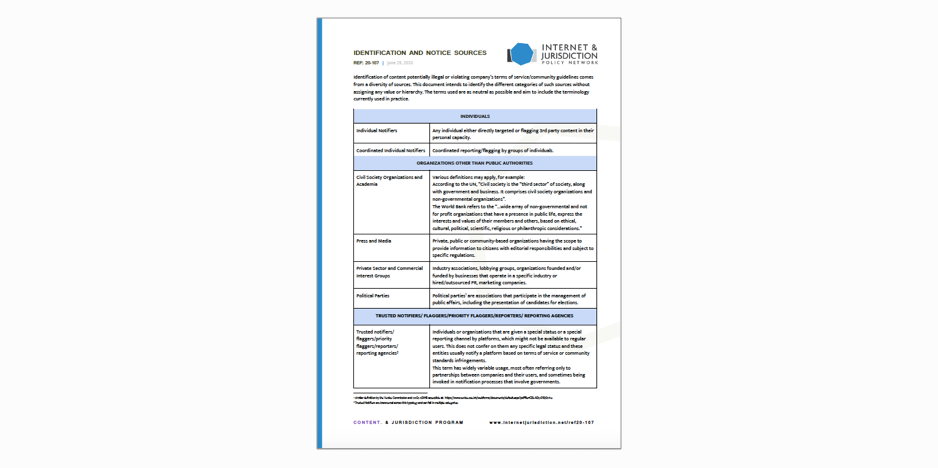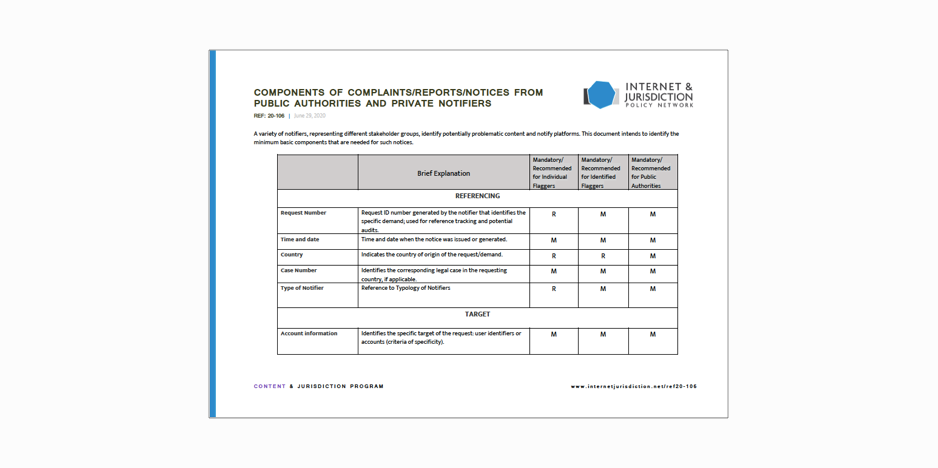Download the new I&J Outcome: Resource on Identification and Notice Sources (REF: 20-107)
Download the new I&J Outcome: Resource on Components of Complaints/Reports/Notices from Public Authorities and Private Notifiers (REF: 20-106)
Over 30 senior-level global key actors from governments, internet companies, technical operators, civil society, leading universities, and international organizations, have worked together in the Internet & Jurisdiction Policy Network Content & Jurisdiction Program Contact Group, to map key elements of content moderation. The resources aim to help frame approaches towards identification and reporting of problematic online content and build a common understanding of the processes that can ensure due process.
One of the key challenges in dealing with online content is addressing abuses in a way that is timely and effective, yet fully respectful of international human rights principles while enabling the further development of the digital economy. The process of content moderation can often involve several jurisdictions. To enable the coexistence of different norms in online spaces, and to ensure that content restrictions are necessary and proportionate, it can be helpful to divide the process of content moderation into four stages: identification and notification, evaluation, choice of action, and recourse.
Meet the Members of the Content & Jurisdiction Program Contact Group
I&J Outcome: Resource on Identification and Notice Sources (REF: 20-107)
A broad range of actors identify and notify platforms about content that is potentially illegal or violating a company’s terms of service/community guidelines. The notifications by different actors can carry different weight and legal status depending on the nature and type of notifier. Therefore as the first step in mapping out the process, Members of the Content & Jurisdiction Program Contact Group have produced a typology of notifiers.
This document intends to identify the different categories of notifiers without assigning any value or hierarchy. The terms used are as neutral as possible and aim to include the terminology currently used in practice.
The notifiers covered in this typology could be represented in multiple categories and the typology does not establish the relevance of the notification provided, which should be evaluated on its own merits.
I&J Outcome: Resource on Components of Complaints/Reports/Notices from Public Authorities and Private Notifiers (REF: 20-106)
Another step of the identification stage in content moderation is effective notices to platforms on potential problematic content. Notifiers should ensure that the notifications contain all the necessary information for swift and efficient processing by the internet intermediaries.
This second resource contains a list of components that should be included in any notification that is made by either individuals, identified notifiers (including trusted flaggers), or public authorities. The components are categorized as either mandatory or recommended depending on the category of the notifier.
A variety of notifiers, representing different stakeholder groups, identify potentially problematic content, and notify platforms. The document intends to identify the minimum basic components that are needed for such notices.
The two resources build on the outcome of the work of Members of the Internet & Jurisdiction Policy Network’s Content & Jurisdiction Program Contact Group. In 2019, the Members developed a set of Operational Approaches that provide stakeholders with common Norms, Criteria, and Mechanisms regarding content moderation and restrictions.
The Internet & Jurisdiction Policy Network is the multistakeholder organization addressing the tension between the cross-border internet and national jurisdictions. It engages over 300 entities from governments, the world’s largest internet companies, technical operators, civil society groups, academia, and international organizations from over 50 countries.




